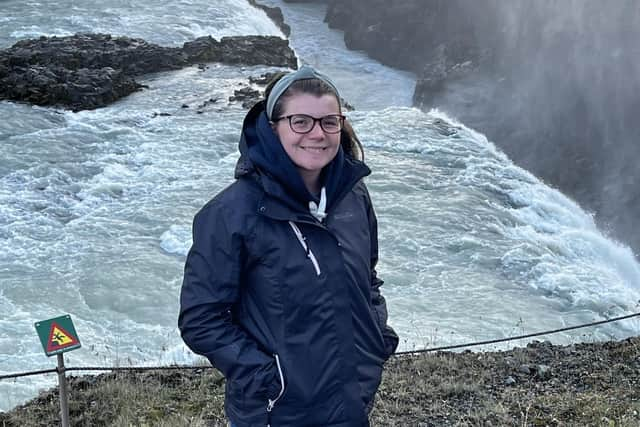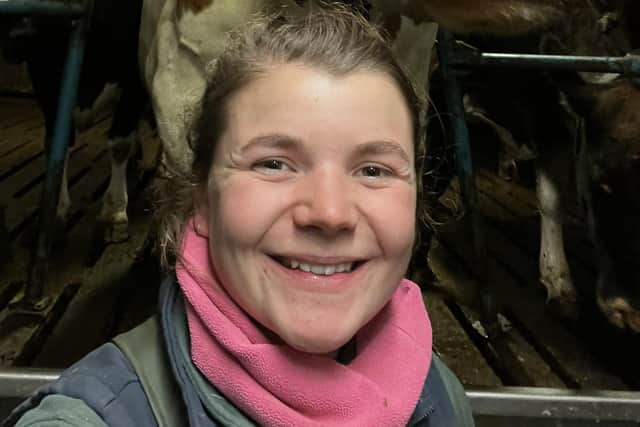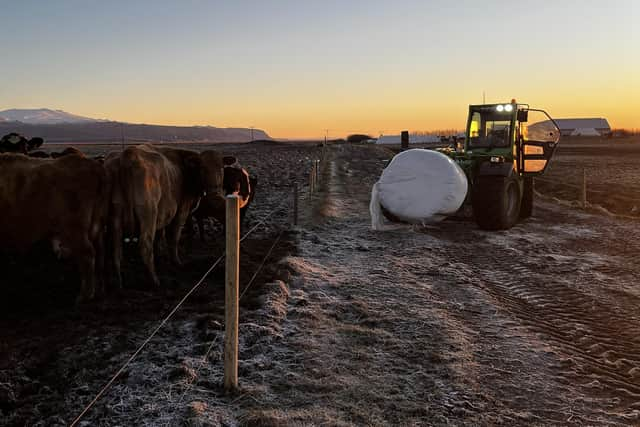Meet the young Yorkshire farmer who took her skills to a dairy in Iceland
This was the gist of the extraordinary opportunity a dairy farmer’s daughter from the East Riding chanced upon in September last year, which led to an experience that she will never forget in the North Atlantic when she landed the job in Iceland.
Katie Gowthorpe, who grew up at Favin Farm in Laytham, says she hadn’t been looking specifically to visit Iceland but she was in the market for something new and exciting in her life, something completely different. Volcanoes? Maybe not what she’d had in mind, but the rest of the advertisement appealed.
Advertisement
Hide AdAdvertisement
Hide Ad“They were putting in three robotic milkers, which is what enticed me to see them in terms of dairy farming,” says Katie. “But it was also the experience of seeing another way of life from what I was used to. It was when I’d been scrolling through Facebook one Sunday afternoon that I came across the job advert and it sounded amazing.


“I flew into Reykjavik and from there it was a two-hour drive to the south coast. The farm I was going to be working on was near what they call a town called Hvolsvollur. It’s a village to us in England. Jonny’s family was lovely and they were really fun to be with and so chilled out, which suited me.
Katie spent from September to December with farmer Jonny and his family and says the difference between dairy farming in Iceland and Yorkshire was for her a stark comparison.
“It was not at all like working on a dairy farm the way that I’ve been used to. It was very laid back. There was no rush to do anything. I did all sorts of work. Milking the cows, a bit of tractor work, general farm work.
Advertisement
Hide AdAdvertisement
Hide Ad“They were in a share farming scheme where so much of the equipment was shared between so many farms. I had to go to a farm to pick up a trailer to lead bales with. They also had all the tillage equipment there, the plough, the power harrow.


Katie was taken with the approach to modern methods of dairy farming that have been taken up by many on the island.
“Icelandic dairy farmers invest heavily in technology, not necessarily from a tractor perspective I wouldn’t say, but on technology on the dairy side they are very advanced.
“Robotic milkers, automated robotic scrapers, automated feeding systems are all common among dairy farms in Iceland. I heard that half of the country’s 600 dairy farms are now operating robotic milking.
Advertisement
Hide AdAdvertisement
Hide Ad“Most farms over here in England still have the mixer wagon on a tractor. In Iceland many also have automated feeding systems where they fill up a bunker once a day and the bunker will then empty into an automated feeder wagon which will then go and feed the dairy cows. It saves a lot of labour. The automated feeding system where I was had been in for over 20 years, so from that point of view they are very much in front.


Katie says the payment Icelandic dairy farmers receive for their milk is much better than in England.
“The end margin of their product is a lot higher than you see in England. There’s a lot more money at it. In Iceland they were receiving the equivalent of £1 per litre while I was there and the price only ever went up. That’s double the price dairy farmers were getting when the milk price was at its height over here a few months ago.
“There is only one milk processing company in the country and the dairy farms are controlled by quotas like dairy farmers used to be when there was the Milk Marketing Board.
Advertisement
Hide AdAdvertisement
Hide AdThe traditional Icelandic dairy cow is a small-bodied animal that can be bred in a variety of markings. Katie says the breed looks like a cross between a British Friesian and a Jersey.
“They can come out any colour and Jonny’s cows produce a herd average of around 7000 litres. He keeps them mostly inside, turning them out eight weeks of the year when the weather is decent, but he finds it easier, because of them also now going to the robots, to keep them on a more consistent diet inside.
“All of the farm buildings are also well insulated, so it wasn’t freezing while you were milking unless there was a cold wind blowing through.
Katie says she coped with Iceland’s naturally cold climate and that by the time December came around she was feeling it a little, but the views from the farm, the fabulous places she visited and night after night of watching the Northern Lights were her payback.
Advertisement
Hide AdAdvertisement
Hide Ad“The farm was on a bit of a hill and on a clear day you could see the sea and directly opposite the Vestmann Isles.
“I reckon I could live in Iceland if the opportunity ever arose. For the amount of people who live there the infrastructure is just superb. I was never once without a phone signal and the roads are well maintained.
“It was cold in December. It got to minus 7 degrees before I left and minus 22 degrees later. I was starting to feel the cold a lot, but they did provide insulated overalls a bit like a snowsuit.
“I visited some fantastic places, like swimming out to the geothermal Sky Lagoon, but one morning I woke up, went outside to milk and just stood there in awe watching the Northern Lights dancing.
Advertisement
Hide AdAdvertisement
Hide Ad“In Reykjavik, one night, I looked up at the sky and it was green, pink, red, all pretty colours dancing around. They are truly spectacular.
Katie loves dairy farming. She has recently taken on a role as a ruminant sales specialist with Thompsons of York.